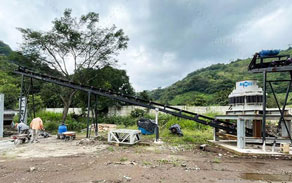


Understanding these material interactions separates successful granite operations.
Granite deposits rarely occur in pure, homogenous formations, with various impurities significantly influencing crushing plant performance and end-product quality. The presence of clay intrusions, iron-bearing minerals, and moisture content transforms what appears to be straightforward rock processing into a complex materials handling challenge. These contaminants affect equipment wear rates, production efficiency, and product specifications in ways that demand careful system design and operational adjustments. Understanding these material interactions separates successful granite operations from those plagued by unexpected downtime and substandard aggregate production.
The crushing process magnifies the effects of seemingly minor impurities – clay content as low as 3% can reduce throughput by 40% through chamber packing, while iron staining that appears purely cosmetic may accelerate wear part deterioration by 300%. Water content variations create equally disruptive effects, with surface moisture differences of just 2% altering flow characteristics through the entire crushing circuit. These factors collectively determine whether a granite deposit becomes an economic asset or a processing nightmare.
Clay minerals form adhesive coatings on crushing surfaces that reduce effective chamber volume and disrupt material flow. In jaw crushers, this manifests as premature toggle plate failures from excessive pressure buildup. Cone crushers experience uneven mantle wear patterns as clay alters particle trajectories. The most advanced plants now incorporate high-frequency vibration systems that prevent material adhesion without compromising structural integrity.
Clay’s water absorption properties create processing challenges that fluctuate with weather conditions. Dry clay becomes abrasive dust, while hydrated clay forms viscous masses. Modern plants address this through humidity-compensating feed systems that adjust granite crusher machine speed and gap settings based on real-time moisture monitoring, maintaining consistent output despite material variations.
Iron-bearing minerals like magnetite and hematite possess Mohs hardness ratings that often exceed the granite matrix itself. When liberated during crushing, these particles accelerate wear on liners, concaves, and mantles at rates disproportionate to their concentration. Premium crushing plants now utilize composite wear materials with ceramic inserts specifically designed to resist this accelerated wear pattern.
Iron staining affects more than equipment longevity – it creates quality control challenges for concrete aggregate specifications. Optical sorting systems have emerged as the solution, using multispectral imaging to detect and reject iron-contaminated particles without sacrificing good material. These systems add 15-20% to plant costs but preserve premium product pricing integrity.
Optimal moisture levels balance dust suppression needs against material handling requirements. Too dry, and airborne particulates create environmental and health hazards. Too wet, and material bridges in hoppers. Modern plants achieve this balance through atomized spray systems that apply precise moisture doses at multiple processing stages, adjusted automatically by particle size analyzers.
When combined with certain mineral impurities, water initiates galvanic corrosion that attacks crusher components. High-performance plants now employ cathodic protection on vulnerable surfaces and use stainless steel in critical wear zones. These measures extend component life by 200-400% in humid operating environments.
The interplay between granite impurities and crushing systems demands a materials science approach rather than conventional aggregate processing thinking. Successful operations now employ mineralogical analysis during plant design, creating systems tailored to their specific deposit characteristics. This proactive strategy prevents the 25-35% productivity losses typical of plants designed for “ideal” granite processing but facing real-world material challenges. The difference between theoretical and actual performance often comes down to how effectively a plant handles these impurities, making them a critical factor in both equipment selection and operational planning.
